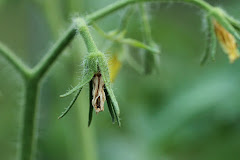 It looks like a banner year for fruit set based on an informal look at fruit trees and conversations with Front Range fruit tree owners. Apricots and peaches may set fruit in an average of 2 years out of 5 and they both have fruit this year. Later blooming cherries (see photo left) and apples bloomed when temperatures were above 28 degrees also escaping freezes when in bloom.
It looks like a banner year for fruit set based on an informal look at fruit trees and conversations with Front Range fruit tree owners. Apricots and peaches may set fruit in an average of 2 years out of 5 and they both have fruit this year. Later blooming cherries (see photo left) and apples bloomed when temperatures were above 28 degrees also escaping freezes when in bloom.The danger now appears to be too heavy a fruit set. Peaches tend to set fruit too heavily and should be hand-thinned when fruit reaches 1 inch in size. Space fruit 6 inches apart (see photo). Apricot fruit should be thinned the same way and thinning will produce larger-sized fruit just like peaches.

In a heavy-set year, we inevitably get July and August phone calls from people whose home peach tree limbs have broken from the heavy fruit load. Remember that peaches only bear on 1 year old wood and bearing branches will be removed at the end of the season, leaving this year’s branch growth to bloom and produce fruit in 2011.
Apples are not always thinned but could benefit from thinning in the case of heavy set (photo left). Natural “June drop” is typical in heavy fruit set years but may not always thin fruit enough. Thin in June to 6 to 8 inches or to every other spur. Break up clusters leaving only single fruit. DO NOT remove the long-lived spurs, only the fruit. Thinning fruit produces larger fruit.
left). Natural “June drop” is typical in heavy fruit set years but may not always thin fruit enough. Thin in June to 6 to 8 inches or to every other spur. Break up clusters leaving only single fruit. DO NOT remove the long-lived spurs, only the fruit. Thinning fruit produces larger fruit.
Sour cherries also have spurs that produce for 2 to 5 years. Clusters are not generally thinned. Sweet cherry trees are less favored for the Front Range and not as hardy as sour cherries and other stone fruits. Branches can winter kill.
Apples are not always thinned but could benefit from thinning in the case of heavy set (photo
 left). Natural “June drop” is typical in heavy fruit set years but may not always thin fruit enough. Thin in June to 6 to 8 inches or to every other spur. Break up clusters leaving only single fruit. DO NOT remove the long-lived spurs, only the fruit. Thinning fruit produces larger fruit.
left). Natural “June drop” is typical in heavy fruit set years but may not always thin fruit enough. Thin in June to 6 to 8 inches or to every other spur. Break up clusters leaving only single fruit. DO NOT remove the long-lived spurs, only the fruit. Thinning fruit produces larger fruit.Sour cherries also have spurs that produce for 2 to 5 years. Clusters are not generally thinned. Sweet cherry trees are less favored for the Front Range and not as hardy as sour cherries and other stone fruits. Branches can winter kill.
Photo credit: Cherry bloom, Peach fruit thinning, Heavy apple set - All Carl Wilson








